Welcome to the vibrant world of the Flame Angelfish, known for their fiery colors and mesmerizing patterns. Originating from the serene waters of the Pacific Ocean, these tropical gems are a captivating sight in any aquarium.
Getting to Know the Flame Angelfish
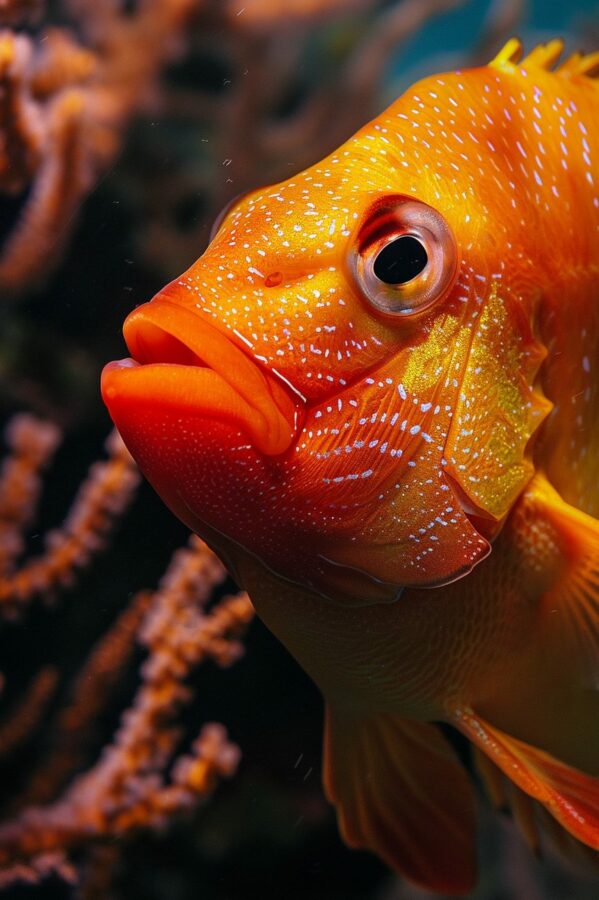
The Flame Angelfish is a visually striking species that is a popular choice among marine aquarists. It is known for its bright coloration and dynamic presence within a saltwater habitat. This species, scientifically named Centropyge loricula, thrives in the warm waters of the tropical Indo-Pacific region and has a distribution that includes areas like Australia and Hawaii.
In appearance, the Flame Angelfish exhibits a fiery palette of red to orange hues, complemented by distinctive vertical black stripes and a subtly blue-tipped dorsal fin. These characteristics make it one of the aquatic community’s most recognizable and appealing fish.
Typically, these angelfish reach an adult size of around 6 inches, making them smaller than other oceanic angelfish species. Despite their size, they command attention with vivid coloring and swift movements.
Habitat and Social Structure
Attribute | Description |
|---|---|
Preferred Habitat | Bottom layers of aquatic environments |
Social Behavior | Forms harems of 3-7 individuals |
Shelter | Often retreats to rocks and stony corals |
Aquarists should provide a tank that emulates their natural habitat to ensure their well-being. A pH level between 8.1 and 8.4 is crucial for maintaining their health, as fluctuations can lead to stress and disease. Sustaining a pristine environment and offering proper nutrition, which may include phytoplankton or microscopic algae, especially during the larval stage, is essential for their care.
This dazzling species, scientifically named Centropyge loricula, loves to play hide-and-seek among reefs and lagoons. They are abundant around Australia, Samoa, and parts of Indonesia. The Flame Angelfish, with its brilliant blend of orange, red, blue, and black, remains consistent in appearance throughout its lifespan. Not changing with age is unique among angelfish.
Nutrition for the Flame Angelfish
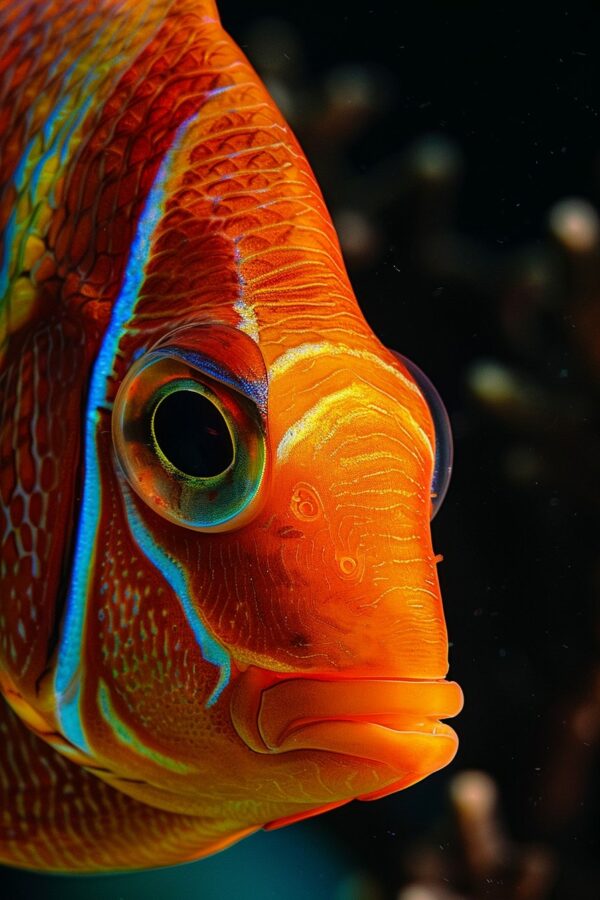
Do you want to guess their primary food in the wild? It’s seaweed and small crabs. However, when kept in aquariums, these angelfish are surprisingly unpretentious and will happily settle for dried or frozen food.
Frequent Feeding
Unlike other saltwater fish, Flame Angelfish are not picky eaters. They do, however, love to eat throughout the day. So, keeping them satisfied with small portions is better than having one or two big feeds. And remember, if natural seaweeds are unavailable in your tank, dried algae replacements are a good alternative.
Creating the Perfect Environment
Your aquarium should mimic their natural habitat so that these angelfish feel at home. That means aiming for a water temperature of about 24°C to 28°C and a tank that can hold at least 350 liters of water. As social creatures, they appreciate company but also need places to hide. And remember, to avoid conflict, it’s best to limit the number of males in a tank.
Living Together
- Peaceful Creature: Flame Angelfish are generally peaceful with other fishes despite their fiery looks.
- Best in Pairs: They do well in pairs of male and female or even a group with several females to one male.
- Love for Territory: Although friendly, Flame Angelfish can become territorial, especially in busy aquariums. One way to counter this is to ensure they have enough space.
The Challenges of Breeding
Breeding Flame Angelfish in captivity is a tough challenge. This, along with their relative fragility during shipping, means their price is higher. Keeping new arrivals in a quarantine tank is highly recommended to ensure their health before including them in the community tank.
Housing these colorful gems, though requiring careful attention, offers rewarding experiences to aquarists. Seeing these aquatic fireworks vibrant and healthy is indeed worth all the effort!
Physical Characteristics
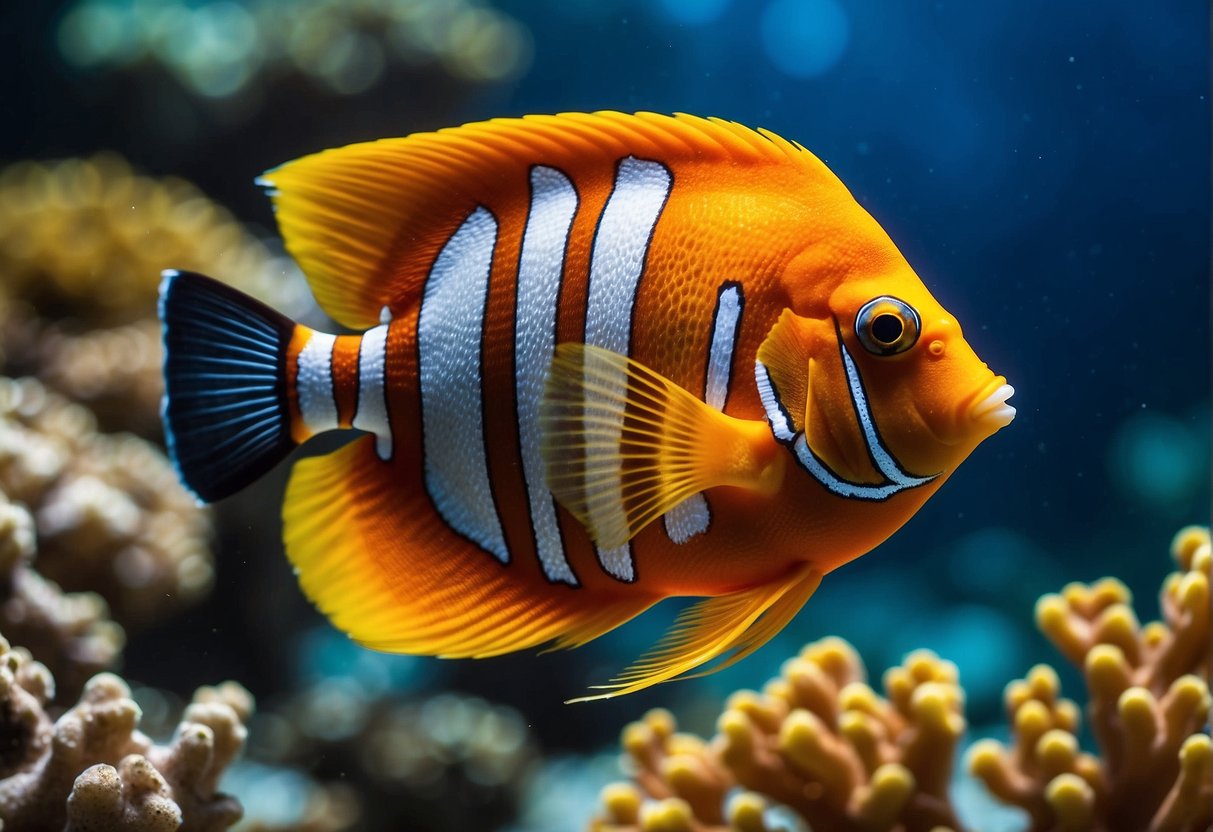
The flame angelfish is a vibrant species with a compact size and notable sexual dimorphism. Its anatomy and rich coloration are primary reasons for its popularity in marine aquaria.
Coloration and Pattern
The primary hue of the flame angelfish’s body is a deep orange to red, embodying the fiery essence its name suggests. This vivid coloration is accented by dark vertical stripes that add to its striking appearance. Typically, a pale to deep blue outlines the edges of their anal and dorsal fins, contributing to the fish’s contrast against aquatic backdrops.
Fins and Body Structure
They possess a slender, circular body profile, growing to an average length of 4 inches at full maturity. The flame angelfish has well-defined fins—including the dorsal and anal fins—which are edged with subtle shades of blue. Their body structure is ideally suited to the reef environment, offering agility and grace amidst the complex habitats.
Sexual Dimorphism
Males of the species tend to be slightly larger and often exhibit more extensive blue edging on their fins compared to females. Additionally, during spawning, discernible physical differences may become more prominent, with males displaying intensified coloration. This dimorphism is less apparent in juveniles but becomes more distinct as the fish reach sexual maturity.
Natural Habitat
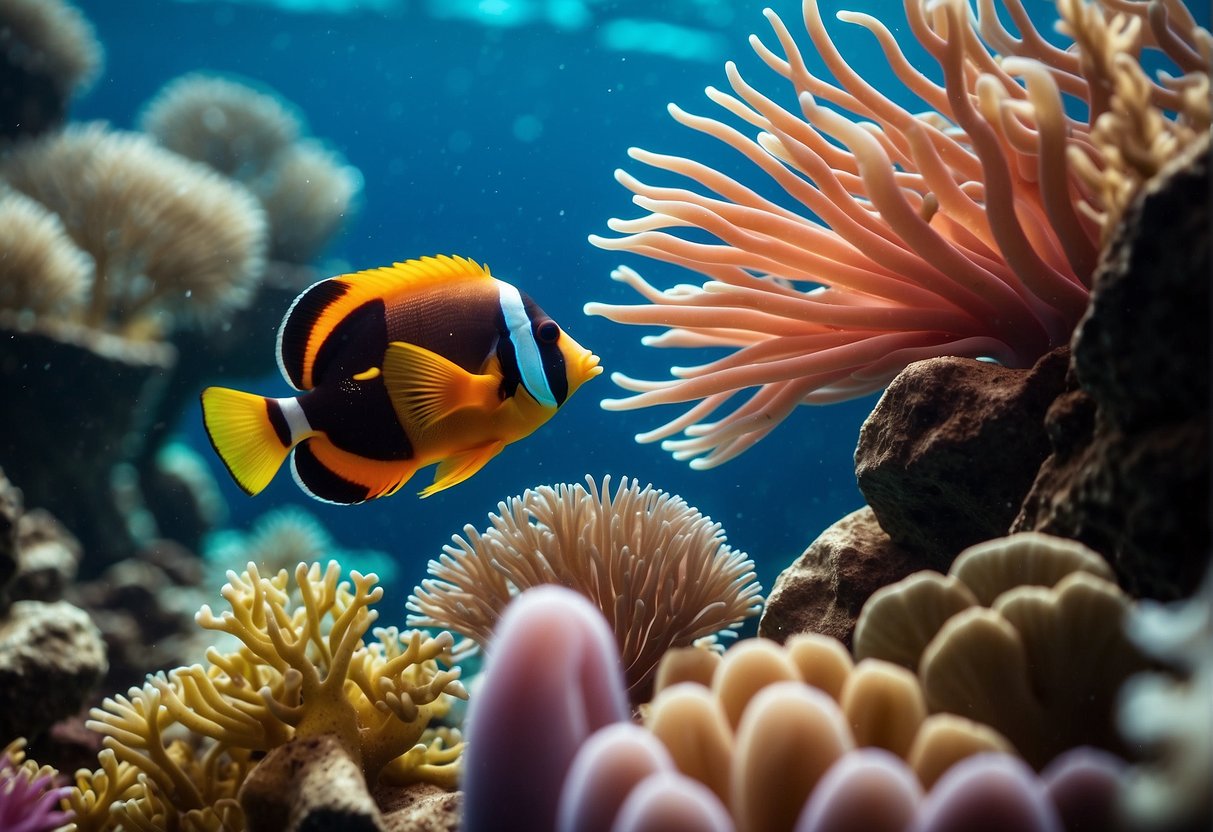
The Flame Angelfish, known scientifically as Centropyge loriculus, exhibits a remarkable affinity for the warm and shallow waters of the Indo-Pacific. These fish grace the underwater landscapes with vivid hues, predominantly inhabiting the coral-rich regions.
Location and Environment Typically, these marine species are dispersed through environments from eastern Indonesia to the Marquesas Islands, including the eclectic ecosystems of Palau to the Society Islands. The ocean’s architectural marvels, the coral reefs, serve as the quintessential habitat for the vibrant Flame Angelfish, which thrive within the crevices and interstices they provide.
Water Depth and Features
- Depth Range: 10-100 feet
- Features: Abundant coral growth with shelters such as crevices, caves.
Behavioral Adaptations In their quest for sustenance and protection, the Flame Angelfish meticulously navigate their coral dominions. They are creatures of habit, opting to stay relatively shallow rather than venturing into the ocean’s abyss. These agile swimmers prefer areas where reef structures are prolific, offering an interplay of refuge from predators and abundant food sources.
Aquarium Care
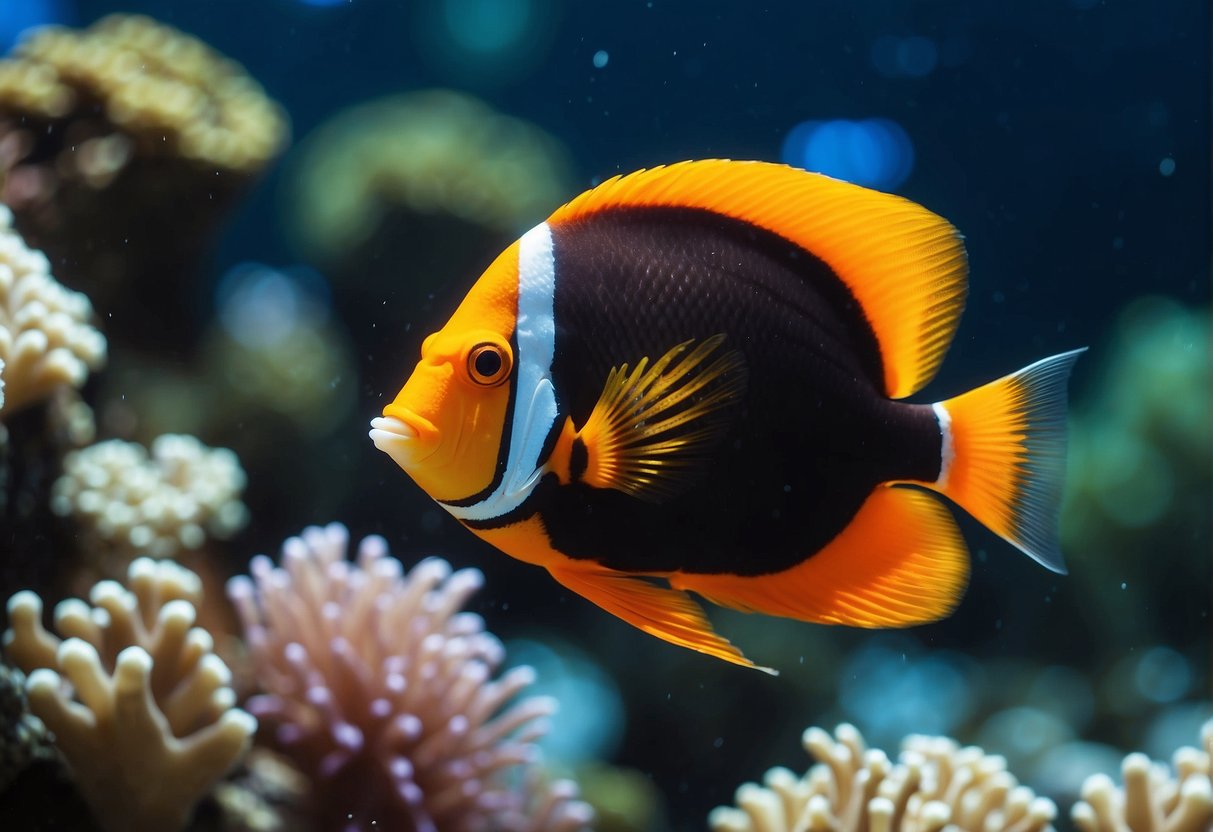
Proper aquarium care is essential for maintaining the health and vibrancy of flame angelfish. This section offers specific guidelines for tank setup, water parameters, diet, and disease prevention.
Tank Requirements
Flame angelfish thrive in a saltwater aquarium that is at least 70 gallons to provide ample space for swimming and hiding. The tank should also contain live rock for algae grazing and to facilitate natural behaviors. A peaceful community tank is preferred to prevent stress and competition for resources.
- Minimum Tank Size: 70 gallons
- Environment: Saltwater with live rock
- Tank Mates: Peaceful species
Water Conditions
Maintaining stable water conditions is critical for the wellbeing of flame angelfish. The temperature should be between 75°F and 79°F. The pH level requires careful monitoring to stay within 8.1 and 8.4. Consistent water quality can be achieved through regular testing and maintenance routines.
- Temperature: 75°F – 79°F
- pH Level: 8.1 – 8.4
Feeding
Flame angelfish have a varied diet that should include meaty food and algae. Incorporate mysis shrimp, spirulina, and high-quality marine flakes or pellets to provide balanced nutrition.
- Primary Diet: Meaty foods, algae
- Recommended Foods: Mysis shrimp, spirulina, marine flakes, pellets
Health and Disease Management
Vigilance is key to identifying and treating common ailments such as ich, a parasitic infection. Preventative measures include maintaining optimal water conditions and providing a diverse diet to support a robust immune system.
- Monitor for signs of ich or other diseases
- Maintain optimal water conditions
- Provide a nutrient-rich diet for immune health
Behavior and Compatibility
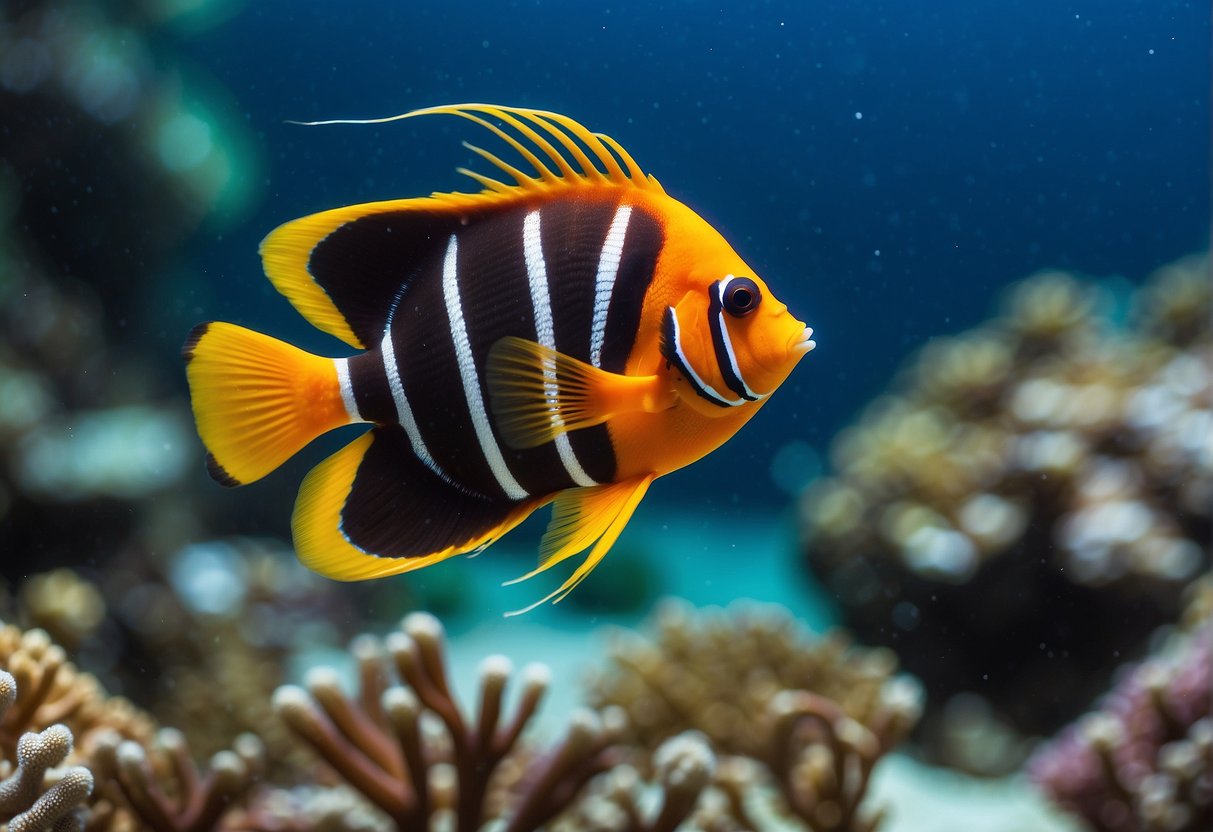
The Flame Angelfish (Centropyge loriculus) exhibits a temperament that, while occasionally territorial, leans towards the peaceful end of the spectrum. They thrive in environments that are well-structured, with ample hiding spaces like caves and crevices. Typically, a Flame Angelfish will exhibit reserve upon introduction to a new aquarium, often seeking shelter amongst rockwork.
In terms of compatibility within a community aquarium, it’s essential to pair the Flame Angelfish with non-aggressive species. Aggressive tank mates can stress these fish, leading to behavioral issues. These angelfish do not naturally form schools but can coexist with a variety of peaceful fish. However, for their well-being, it’s prudent to limit the presence of their own species, as they can show aggression towards each other.
- Behavior:
- Initially shy and reserved
- Territorial but generally peaceful
- Temperament:
- Adaptable after acclimation
- Can exhibit aggressive behavior towards conspecifics
- Compatibility:
- Avoid aggressive species to prevent stress
- Prefer peaceful communities
The Flame Angelfish’s diet should consist of a variety of meaty foods, with both frozen and dried options being suitable. Creating a conducive and harmonious tank environment plays a crucial role in the behavioral health of these fish. When considering a Flame Angelfish as a potential addition to an aquarium, reflecting on the existing community’s composition and environmental arrangement will significantly contribute to the successful integration and stability of this vibrant species.
Breeding
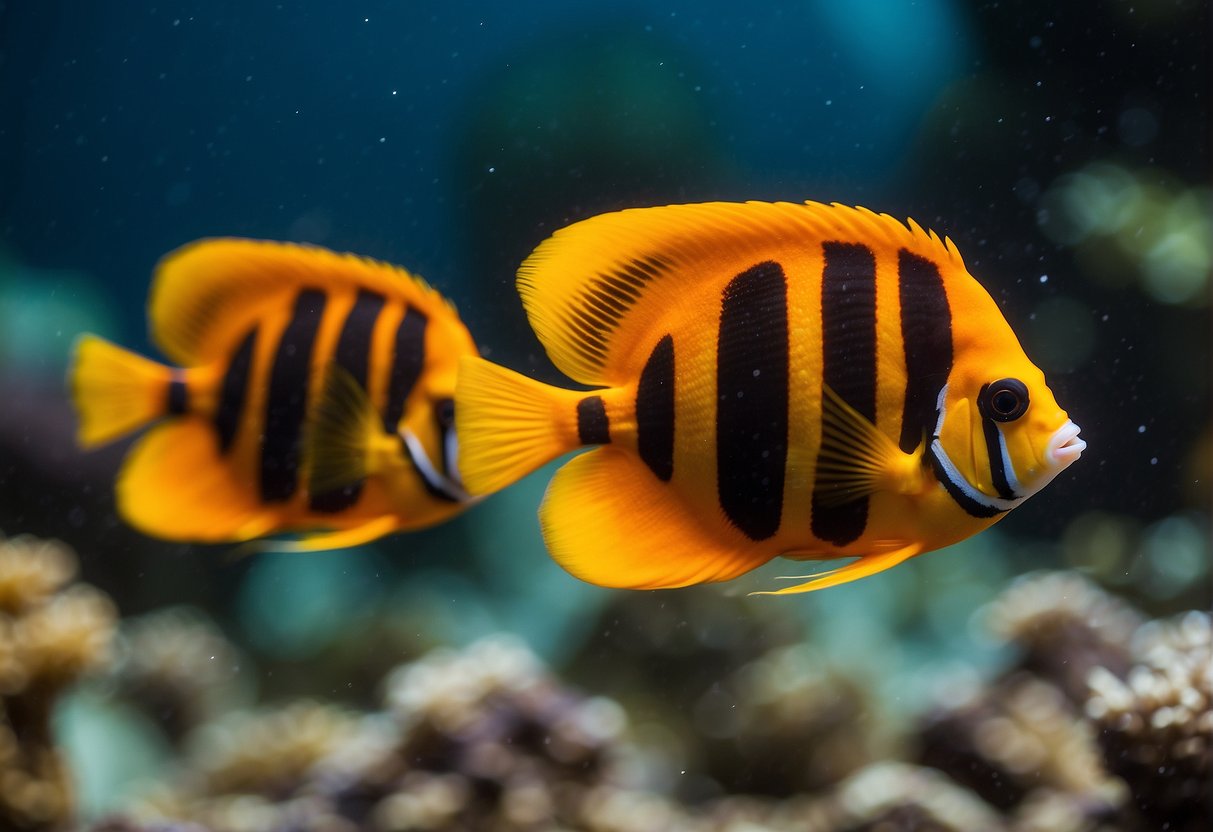
Breeding flame angelfish (Centropyge loricula) presents a notable challenge within the marine aquarium hobby. These vibrant marine creatures exhibit a complex life cycle—their larval stage alone may exceed 100 days, which contributes to a decreased chance of survival to adulthood. Success rates for raising flame angelfish from spawn to maturity are low, despite the aquarist’s best efforts.
Spawning typically takes place early in the evening, unexpectedly for many. The adults require isolation in a separate breeding tank to increase the likelihood of the larvae’s survival. Predation on the eggs by other tank inhabitants is a risk if the parents are not moved.
Key Aspects of Flame Angelfish Breeding:
- Spawning Timing: Occurs early evening
- Larval Stage: Up to 100+ days
- Survival Rate: Generally low
After spawning, the flame angelfish larvae demand specialized nutrition, like phytoplankton or microscopic algae, to thrive. Caring for larvae entails providing these particular dietary needs and monitoring for potential threats within the breeding tank.
The reproduction of flame angelfish in home aquariums is rarely accomplished, and the fish available to enthusiasts are predominantly wild-caught. These facts point towards a need for advanced aquaculture techniques and dedication from the aquarist aiming to breed flame angelfish successfully.
Breeding these fish necessitates a substantial aquarium with adequate swimming space to accommodate them as they grow. The journey from egg to fry, and eventually to a mature flame angelfish, is fraught with challenges, but the vibrant beauty of successfully bred individuals makes the endeavor worthwhile for dedicated aquarists.
Selecting Your Flame Angelfish
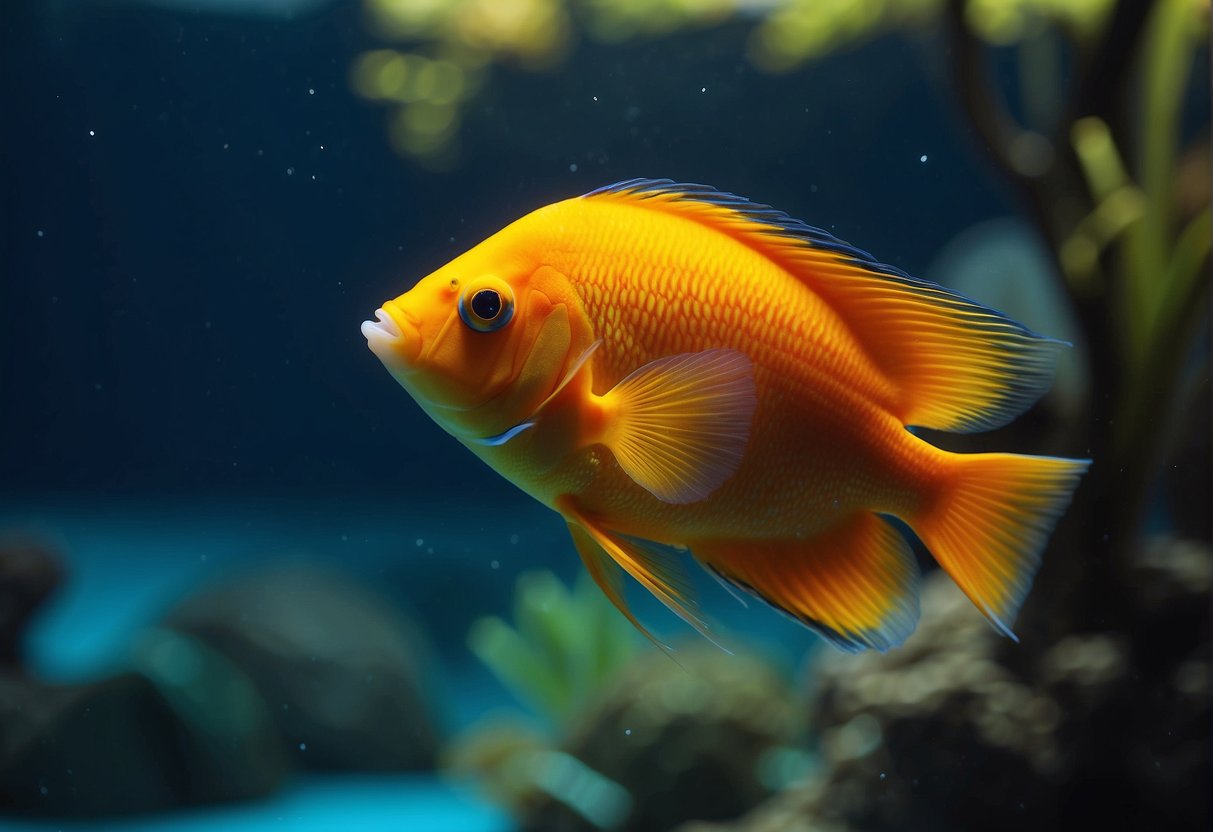
When choosing a Flame Angelfish (Centropyge loricula) for your aquarium, attention to detail is pivotal. This species, distinct for its vivid coloration reminiscent of the animated character from “Finding Nemo,” draws the eye with its fiery hues. To ensure a healthy specimen, observe the following pointers:
Health and Activity: Carefully observe the fish’s behavior. A vigorous Flame Angelfish should display active swimming and exhibit curiosity towards its environment. Lethargy or a clamped fin can signal poor health.
Coloration: Look for bright and uniform coloration without dull patches. The rich red to orange gradient marking a healthy Centropyge loricula should be vibrant. Paleness may indicate stress or disease.
Body Condition: Assess the fish’s body condition; a well-proportioned body and clean, intact fins are signs of a prime specimen. Any spots, lesions, or ragged fins could indicate underlying issues.
Compatibility: Consider the current inhabitants of your tank. Flame Angelfish tend to be territorial; a peaceful community increases the likelihood of successful integration.
Quarantine: If possible, inquire about the quarantine procedures the retailer has followed. Quarantining new arrivals helps prevent the spread of disease to your established tank community.
Purchase and Acclimation
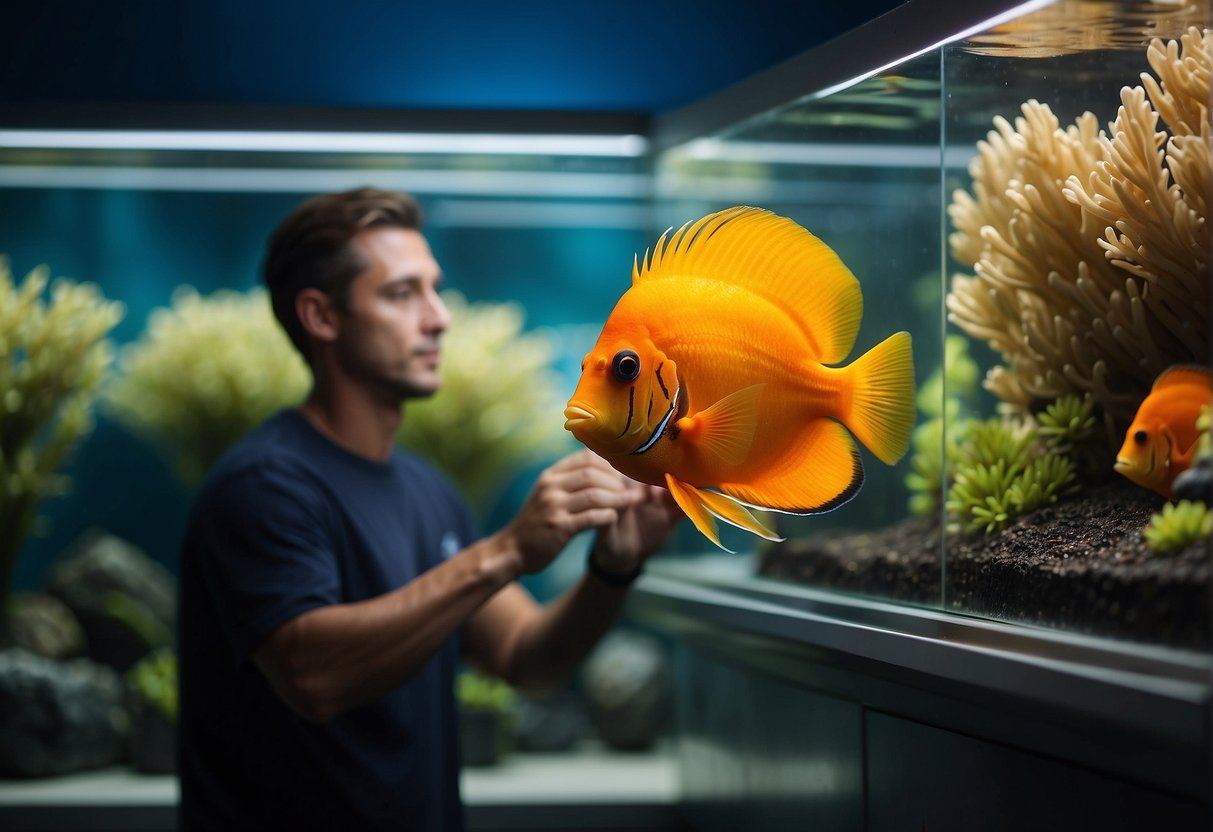
When acquiring a flame angelfish, one must navigate the complexities of transportation and the necessity of a careful acclimation process to ensure the well-being of this sensitive marine species.
Transport and Shipping
Upon purchasing flame angelfish, especially when procured online or from a distance, it is crucial to consider the size at which the fish is sold, as this can impact its vulnerability during transport.
Stores usually offer a guarantee of safe delivery and health upon arrival. It is advisable to read customer reviews and verify the store’s reputation before placing an order. The shipping process should minimize stress on the fish, with the delivery system being prompt to reduce time spent in transit.
Acclimating to New Environments
The acclimation of flame angelfish to new environments is a delicate process. Begin by placing the bag containing the fish in the aquarium water without opening it, allowing the temperature inside the bag to align with the aquarium for about 15-30 minutes. Next, gradually introduce small amounts of aquarium water to the bag every few minutes for the next couple of hours to equalize water parameters such as pH and salinity.
Acclimation Steps:
- Temperature Equalization: Allow the sealed bag to float for 15-30 minutes.
- Water Integration: Add small increments of aquarium water at intervals.
- Full Introduction: Introduce the flame angelfish to the aquarium after achieving parameter congruence.
The flame angelfish’s sensitivity to abrupt changes underscores the need for gradual acclimation. Industry best practices suggest the use of a drip line system to stabilize water parameters effectively. It is also imperative to monitor the fish closely during and after the acclimation to ensure a successful introduction to their new habitat.
Conservation and Ethical Considerations

Conservation efforts for the Flame Angelfish (Centropyge loriculus) are crucial due to their popularity in the marine aquarium trade. Capturing wild specimens can lead to population declines and disrupt local ecosystems. Aquaculture, or the farming of aquatic organisms, emerges as an ethical alternative, providing a sustainable approach to meet hobbyist demand without harming natural populations.
- Wild Caught: The collection of Flame Angelfish from the ocean can result in habitat damage and unsustainable practices.
- Aquaculture: Breeding and raising in controlled environments helps conserve wild populations and habitats.
The ethical implications of maintaining marine life in captivity also necessitate attention:
- Habitat Replication: Aquariums should strive to mimic the natural environment, including temperature and reef-like structures.
- Diet: These fish have a diverse diet in the wild, absorbing pigments from their food; a balanced diet in captivity is essential for their health and coloration.
Ethical considerations extend to the treatment of aquatic wildlife:
- Avoid the misconception that aquarium life is inconsequential.
- Ensure suitable care, including tank conditions and nutrition that align with their natural needs.
Useful Resources: